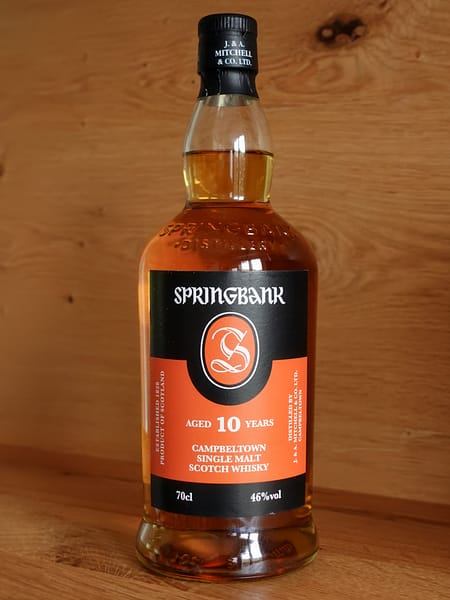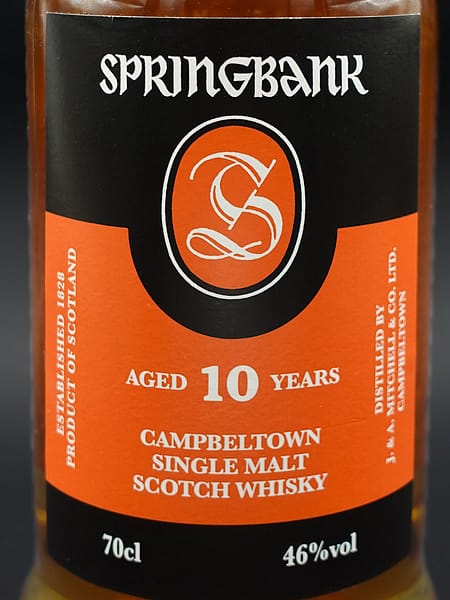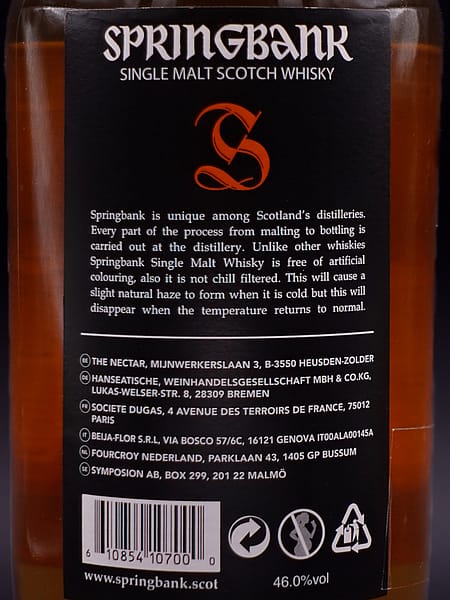If you have been following this series on funky whisky, you will not be surprised to see that the final chapter in the series is dedicated to the distillery at the top of most whisky lover’s list. Today is finally the time to review the Springbank 10 year old. The amount of material written and recorded on Springbank is extensive, so instead of rehashing what others have already said I am going more at the root of the love for this distillery. I am fascinated to understand what makes Springbank so unique to warrant all the hype.
Before I start diving into the Springbank bunnyhole, let’s get one thing out of the way. I am not going to talk about the quality of the whiskies produced. Not because I am casting any doubt on this. Even if I wanted to, I lack both the experience and any circumstantial evidence to do so. I am sidestepping any discussion on quality because, even for someone like me who has had just a handful of Springbank drams, I have become fascinated and excited about this distillery beyond the quality of the spirit produced. Sure part of it is pure unadulterated FOMO. There is something to be said for the satisfaction of hunting for rare whiskies and managing to land one.
But the more I think about it, the more I feel our collective fascination with Springbank says a lot about us. About me certainly, but us whisky geeks probably too.

TL:DR: If a single malt could be compared to listening to hard rock music played through a wall of Marshall amps, this would be it.
Score*: 7.5 Close to being something special.
Tradition, quality and yields.
A big part of the fascination with Springbank is that it is, in the words of Aqvavitae’s Roy Duff, “a working museum”. A museum which is constantly putting quality over quantity. Springbank is the only distillery that carries out its entire production process in-house, from floor malting 100% of the barley used to make its whisky, to maturation. The process is surprisingly free of modern technology: when I visited briefly in March the only “computer” I saw was the notorious board marked with chalk.
While the production could reach 750,000 litres of pure alcohol per year, all the info I could find points to a current output closer to 225,000 litres. It is in good part due to the commitment to traditional methods. And we shouldn’t mistake this for being stuck in the past. This is a conscious decision. Take the choice to malt their own barley. Springbank shut down its floor maltings in 1960 and only restarted to do so in 1992. Nothing forced them to do so except the desire to control that part of the process to ensure the quality of the starting material.
Then there is the production of 3 different spirits, Springbank, distilled two and a half times, Longrow, peated and distilled twice, and Hazelburn, triple distilled. These are produced using the same three stills. Switching from one spirit production to a different one requires adjustments, and slowing down of the production flow. Finally, there is Glengyle. The same crew operating Springbank runs Glengyle for the three months of the year, impacting Springbank’s output capacity as well.
And so we end up with a distillery operating at one-third of its theoretical capacity. Quality over quantity.
Beyond tradition
It’s not as if this is the only way. The Springbank way of doing things does not have the exclusive on producing great whisky. Even its sister distillery, Glengyle, is not operated as traditionally. Further afield distilleries like Ardnamurchan, Benromach, and Lochranza continue to draw praise from the community. They do so without being purists or traditionalists in the way Springbank is. So why do we idolise this one distillery so much it is almost a cult?
The more I think about it, the more I feel this love for Springbank is a case of projection. Projection of our hopes and wishes in the face of an industry we often don’t feel represented by. As whisky geeks or fans (call us what you like), we see the industry go in a direction we disagree with and, at times, actively boycott. Premiumisation, lack of integrity bottlings, decline in quality of beloved brands and lack of transparency can be pinned down to one overarching issue. Greed. And I deliberately say greed instead of profit. Some multinational companies run distilleries prioritising increasing shareholder returns at the cost of maintaining product quality. As passionate consumers, we feel betrayed.
We all need a hero (to look up to)
And so we look at those who remain staunchly independent. We look for the contrarians of the industry. The heroes who give us hope that, even against the economic power of multinational companies, there is hope for high-quality whisky. Quality whisky at a fair price, made through the decision of distillers and not bean counters. And so Springbank has, rightfully, become our figurative Rebel Alliance or Fellowship of the Ring (pick your geeky crew of underdogs now). The ray of sun that gives us hope against the Diageos of the world.
Even more importantly, it is a hero that has not failed us. It has not sold out, unlike some aspiring hero distilleries of the past couple of decades, which ultimately were taken over by corporate giants and transformed into something we at best appreciate without that burning passion that was there before or at worst, despise as a sellout.
Springbank’s owners could easily go the way of Macallan if they wanted, and become a premium whisky with prices to match the hype. They would arguably be more justified in doing so. After all, contrary to Edrington’s top distillery, Springbank’s output is truly limited. And yet, they do not. Sure the secondary and unscrupulous shops prices are often as brazen as you can expect. Yet, Springbank’s RSPs, available here, remain reasonable to say the least. Lucky for us whisky fans, with apparently increasing availibility (at least in the UK and Europe), the mad prices are cooling down and opportunities to get the core releases are increasing.
So have I bought into the cult? As much as I would like to deny it, I suspect I have. Now, will that influence my review of the Springbank 10?
Springbank 10 year old



Specs
Price paid: €75
Lot/bottled date: 22/225, 10/11/2022
ABV: 46^%
Natural colour: Yes
Non-chill filtered: Yes
Casks Used: Not stated but widely reported as 60% ex-Bourbon and 40% ex-Sherry
Tasting Notes
Colour: A rich golden colour, 100% natural
Nose: This is one intense dram, I can smell the aromas keeping my nose a good 10-15 cm away The core is a sweet creamy vanilla-laced fruit salad with peach, mango, pineapple, a little raisin from the Sherry cask and even some unripe strawberry. Then some spice, white pepper, ginger, orange and grapefruit peel, and caramel. The malt-driven notes, barley sugar and oatcakes, are subdued but noticeable.
A further layer of maritime sea spray notes, a touch of rubbery smoke and a touch of funky dunnage warehouse add a twist and some funk that add to the overall complexity. The Sherry cask influence is noticeable but quite mild compared to what the 40% proportion used in ageing would hint to. Probably the ratio of second fill vs first fill casks is skewed towards the former.
Taste: As with the nose, this 2022 Springbank 10 is very intense on the palate. It has a very good mouthfeel, rich but not oily. The sweet core is balanced by sour, bitter and salty taste sensations. More intense malt notes blend with a rich salted caramel taste. There are plenty of fruit notes (peach, pineapple, strawberry), citrus peel, ginger, and a mild but noticeable wood fire peat note at the back of it all.
The finish is very fruity, like biting into a ripe yellow peach, with malt, citrus peel, caramel, ginger spice and a hint of savoury, almost meaty flavour. Very long. The aftertaste is drying, slightly bitter and with a maritime/mineral aftertaste.
Score*: 7.5
Between very good and something special. When I compare my votes to other reviewers, I realise I am often a little more generous than my peers. This is one occasion where I am probably rating a whisky lower than other reviewers. Is it because the hype built too much expectation? Maybe. But mostly, I am being fair to my scoring scale. Don’t get me wrong. I thoroughly enjoyed the Springbank 10-year-old and doing this review. It is one of the best whiskies I have tasted to date. What it is not, is a whisky to be put on a pedestal. It is one to be savoured without pretence, shared with friends and not stashed away as an item of semi-religious adoration.
* Votes are based on the scoring scale used by Dramface, slightly modified to allow half-points
Would I buy it again?
This is a bottle I will nurse for a while. Springbank 10 is getting easier to find, but it still tends to disappear quickly when it appears for sale. Right now I will focus on trying to grab one of those elusive 12-year-old cask strength bottles. Wish me luck!
Would I offer this whisky to a new drinker?
Have you ever gone back to watch a movie yu adored as a child and realised there was a layer of jokes woven in the story that you only get now as an adult? The Springbank 10 in this review is a bit like that. Unlike the Kilkerran 12 in my previous review, this is a whisky that, in my experience, can impress a new drinker. The intensity of aromas and taste shine even to a relatively inexperienced palate. More experience will reveal more layers and an appreciation of the work behind it. I am very curious to go back to this in another 6 months’ time and see if my perception will change even further. This could be the ideal bottle to take on a personal whisky journey, revealing new layers as our personal understanding of whisky grows.
Interested in my take on a specific whisky style? Check the full Journey here and jump to the relevant Chapter.
As usual, I like to link to other reviewer’s opinions. As you would imagine, there are tons of bloggers and vloggers who have shared their review of the Springbank 10. The list below represents just a tiny fraction of what is available out there: